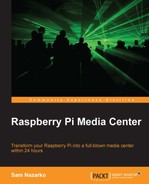Raspbmc can function as both a PVR backend and a frontend. For PVR support in XBMC, it is necessary to have both a backend and one or more frontends. Let's see what a backend and frontend is:
- Backend: A backend is the part that tunes the channel, records your scheduled programs, and serves those channels and recorded television to the frontends. One backend can serve multiple frontends, if it is sufficiently powerful enough and there are enough tuners available.
- Frontend: A frontend is the part that receives content from the backend and plays back live television and recorded programs to the user. In the case of Raspbmc, XBMC serves as the frontend and allows us to play back the content. Multiple frontends can connect to one or more backends. This means that we can have several installations of Raspbmc play broadcast content from even a single tuner.
As we've now learned, Raspbmc has a built-in PVR frontend in the form of XBMC. However, it also has a built-in backend. This backend is TVHeadend, and we'll look at getting that up and running shortly.
There are cases when it is more favorable to use an external, or standalone, backend rather than the one that ships with Raspbmc itself. Outlined as follows is a comparison:
..................Content has been hidden....................
You can't read the all page of ebook, please click here login for view all page.
